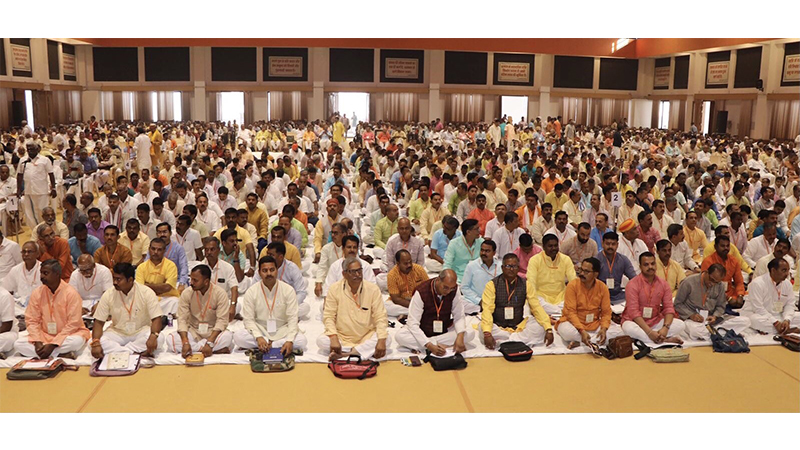Sardar Chiranjeev Singh: A Sikh Pracharak from Punjab who dedicated his life for RSS
Updated: November 22, 2023 13:47

Sardar Chiranjeev Singh, one of the earliest full-time workers (Pracharak) from Punjab who dedicated his life to work for Rashtriya Swayamsevak Sangh (RSS) passed away in Ludhiana after a prolonged illness on November 20, 2023. He was 93. His death was mourned by the nation.
Singh, who served as the president of Rashtriya Sikh Sangat, an RSS inspired organisation that worked among Sikhs, hailed from Patiala in the Indian state of Punjab during his eight-decade long association with the RSS, he served in various roles.
While paying their tributes, RSS Sarsanghchalak (Chief Mentor) Mohan Bhagwat and Sarkaryavah (General Secretary) Dattatreya Hosabale said in a joint statement, “With the demise of respected Sardar Chiranjeev Singh ji, the earthly journey of an inspiring life dedicated to the nation has come to an end. Sardar Chiranjeev Singh ji, a lifelong pracharak of the Sangh, worked for decades in Punjab.
Subsequently, through the work of Rashtriya Sikh Sangat, he played an important role in removing the mutual differences and distrust arising due to the unfortunate situation in Punjab and strengthening unity and social harmony in the entire country in the light of nationalist spirit and understanding. Due to his immense efforts and hard work, deep study of guru-tradition of Punjab and excellent organisational skills, he included innumerable people in the flow of nationalism. Sardar Chiranjeev Singh ji’s affectionate and sweet personality had won over everyone. Despite not being active for some time due to illness, his passion was not dwindling. On the demise of Sardarji, we express our heartfelt condolences and pray to Akal Purush that the departed soul be absorbed in the divine light. Om Shanti.”
Singh was born on October 1, 1930 in Patiala. His father Harkaran Das was a farmer and mother Dwaraki Devi was a school teacher. Singh’s mother had the greatest influence on him during his earlier years. He got associated with the RSS at the age of 14 when he joined a local Sangh shakha with his friend Ravi in 1944. He was quite impressed with the discipline of the shakhas and the custom of adding ‘ji’ to a name as a mark of respect. He completed his Bachelor’s in Arts from Government School, Patiala.
After completing his ‘prathmik varg‘(Primary training camp) in 1946, Singh attended all the three levels of training camps (Sangh Shiksha Varga) in 1947, 1950 and 1952, respectively. He sang patriotic songs and poems beautifully, which was quite appreciated by second Sarsanghchalak MS Golwalkar, popularly known as Shri Guruji. This brought him closer to Guruiji with whom he enjoyed a close relationship.
Singh took part in ‘Satyagraha'(nonviolent protest) and spent two months in jail in 1948. This was the time when the RSS was falsely banned by then government in 1948. After finishing his graduation, he was inspired by a senior Pracharak(full time worker) Babu Shri Chand and he decided to serve the organisation as a full-time worker in 1953 . He worked as a Pracharak in in Malerkotla, Sangrur, Patiala, Ropar and Ludhiana in Punjab. Ludhiana remained the main centre of his work for 21 years. In 1984, he was appointed as the organisational secretary of Vishwa Hindu Parishad (VHP), Punjab.
Under the leadership of Sardar Chiranjeev Singh, over 600 saints reached Amritsar from Haridwar to appeal for the peace in 1987. Rashtriya Sikh Sangat was set up in Amritsar on November 24, 1986. Singh became the general secretary and later the president of the organisation that worked extensively amongst Sikhs and played a significant role in national integration during all those years when Punjab was rocked by militancy. He travelled around the world and his programmes were attended by both Hindu and Sikh communities. He toured many countries, including the United States of America, England, Canada and Germany to spread the message of the Sangh.
In 1999, he organised the Khalsa Sirjana Yatra in Patna (in the Indian state of Bihar). Next year, he participated in World Religion Conference in New York with over 100 saints, including the Jathedar of Anandpur Sahib, a sacred place of worship for the Sikhs.
In 2003, Singh stepped down from the position of the president of the Sangat due to his old age but continued his service at the Sangat’s office in Paharganj ( in Delhi) until 2021. Later, he shifted to Sangh’s office in Ludhiana and continued to guide the young workers of the organisation.












